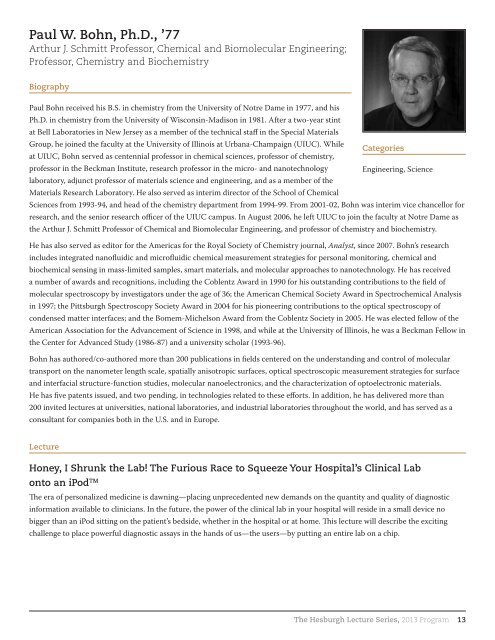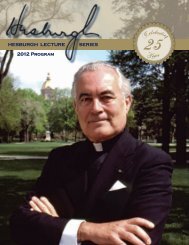HESBURGH LECTURE SERIES 2013 Program - Alumni Association ...
HESBURGH LECTURE SERIES 2013 Program - Alumni Association ...
HESBURGH LECTURE SERIES 2013 Program - Alumni Association ...
Create successful ePaper yourself
Turn your PDF publications into a flip-book with our unique Google optimized e-Paper software.
Paul W. Bohn, Ph.D., ’77<br />
Arthur J. Schmitt Professor, Chemical and Biomolecular Engineering;<br />
Professor, Chemistry and Biochemistry<br />
Biography<br />
Paul Bohn received his B.S. in chemistry from the University of Notre Dame in 1977, and his<br />
Ph.D. in chemistry from the University of Wisconsin-Madison in 1981. After a two-year stint<br />
at Bell Laboratories in New Jersey as a member of the technical staff in the Special Materials<br />
Group, he joined the faculty at the University of Illinois at Urbana-Champaign (UIUC). While<br />
Categories<br />
at UIUC, Bohn served as centennial professor in chemical sciences, professor of chemistry,<br />
professor in the Beckman Institute, research professor in the micro- and nanotechnology Engineering, Science<br />
laboratory, adjunct professor of materials science and engineering, and as a member of the<br />
Materials Research Laboratory. He also served as interim director of the School of Chemical<br />
Sciences from 1993-94, and head of the chemistry department from 1994-99. From 2001-02, Bohn was interim vice chancellor for<br />
research, and the senior research officer of the UIUC campus. In August 2006, he left UIUC to join the faculty at Notre Dame as<br />
the Arthur J. Schmitt Professor of Chemical and Biomolecular Engineering, and professor of chemistry and biochemistry.<br />
He has also served as editor for the Americas for the Royal Society of Chemistry journal, Analyst, since 2007. Bohn’s research<br />
includes integrated nanofluidic and microfluidic chemical measurement strategies for personal monitoring, chemical and<br />
biochemical sensing in mass-limited samples, smart materials, and molecular approaches to nanotechnology. He has received<br />
a number of awards and recognitions, including the Coblentz Award in 1990 for his outstanding contributions to the field of<br />
molecular spectroscopy by investigators under the age of 36; the American Chemical Society Award in Spectrochemical Analysis<br />
in 1997; the Pittsburgh Spectroscopy Society Award in 2004 for his pioneering contributions to the optical spectroscopy of<br />
condensed matter interfaces; and the Bomem-Michelson Award from the Coblentz Society in 2005. He was elected fellow of the<br />
American <strong>Association</strong> for the Advancement of Science in 1998, and while at the University of Illinois, he was a Beckman Fellow in<br />
the Center for Advanced Study (1986-87) and a university scholar (1993-96).<br />
Bohn has authored/co-authored more than 200 publications in fields centered on the understanding and control of molecular<br />
transport on the nanometer length scale, spatially anisotropic surfaces, optical spectroscopic measurement strategies for surface<br />
and interfacial structure-function studies, molecular nanoelectronics, and the characterization of optoelectronic materials.<br />
He has five patents issued, and two pending, in technologies related to these efforts. In addition, he has delivered more than<br />
200 invited lectures at universities, national laboratories, and industrial laboratories throughout the world, and has served as a<br />
consultant for companies both in the U.S. and in Europe.<br />
Lecture<br />
Honey, I Shrunk the Lab! The Furious Race to Squeeze Your Hospital’s Clinical Lab<br />
onto an iPodTM The era of personalized medicine is dawning—placing unprecedented new demands on the quantity and quality of diagnostic<br />
information available to clinicians. In the future, the power of the clinical lab in your hospital will reside in a small device no<br />
bigger than an iPod sitting on the patient’s bedside, whether in the hospital or at home. This lecture will describe the exciting<br />
challenge to place powerful diagnostic assays in the hands of us—the users—by putting an entire lab on a chip.<br />
The Hesburgh Lecture Series, <strong>2013</strong> <strong>Program</strong> 13



